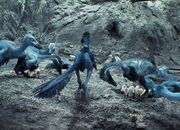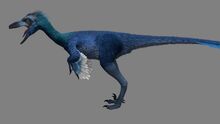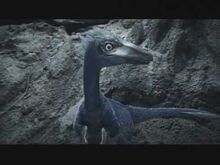
| |
| Creature information | |
| Scientific name : | Pectinodon bakkeri |
| Time period : | Late Cretaceous 66 mya |
| Primary diet : | Omnivore |
| In the series | |
| Fatalities caused : | Some Tyrannosaurus rex Eggs |
| Appearances : | End Game |

A small colony of Pectinodon bakkeri.

Dinosaur.Revolution - End Game.HDTV
Pectinodon was the most intelligent non-avian dinosaur discovered, Pectinodon appeared in the fourth episode of Dinosaur Revolution.
Physical Characteristics[]
Pectinodon were small dinosaurs, up to 0.9 metres (3.0 ft) in height, 2.4 metres (7.9 ft) in length, and up to 50 kilograms (110 lb) in mass. The largest specimens are comparable in size to Deinonychus and Unenlagia. They had very long, slender hind limbs, suggesting that these animals were able to run quickly. They had large, retractable sickle-shaped claws on the second toes, which were raised off the ground when running.
Their eyes were very large (perhaps suggesting a partially nocturnal lifestyle), and slightly forward facing, giving Pectinodon some degree of depth perception.
Intelligence, Brain, and Inner Ear[]
Pectinodon had some of the largest known brains of any dinosaur group, relative to their body mass (comparable to modern birds). Pectinodon's cerebrum-to-brain-volume ratio was 31.5% to 63% of the way from a nonavian reptile proportion to a truly avian one. Pectinodon had bony cristae supporting their tympanic membranes that were ossified at least in their top and bottom regions. The rest of the cristae were either cartilaginous or too delicate to be preserved. The metotic strut of Pectinodon was enlarged from side-to-side, similar to Dromaeosaurus and primitive birds like Archaeopteryx and Hesperornis.

The male Pectinodon.
And is one of the smartest dinosaurs that ever lived and one of the smallest dinosaurs
Discovery[]
Scientists at a British university later conducted a thought experiment related to the evolution of Pectinodon, had it not been so brutally wiped out by the cataclysmic meteorite impact of 65 million years ago. The scientists discovered that, as Pectinodon's eyes grew, his head would have to frequently bend upwards to gain better at sight. The problem was to change the angle at which the spine was to the ground, in other words, to become erect. With Troodon standing upright, there would be no need for a tail to act as a counterbalance, henceforth reducing the requirement for a tail. Pectinodon had become humanoid. Although this is just a thought experiment, it really does give a fascinating glimpse of what evolutionary paths certain lineages of dinosaur may have taken to, had they not been eradicated. This little carnivore was a relative of Saurornithoides, another type of Troodontid, And name by paleontologist Kenneth Carpenter in (1982).
In Dinosaur Revolution[]
In the episode End Game, a group of Pectinodon raided a Tyrannosaurus nest, and one paid the price by being killed. Later after the asteroid hit they were one of the only non-avian dinosaurs to survive, but when the nuclear winter hit, one of the last ones took the last egg and hid in the frozen corpse of a juvenile Tyrannosaurus, which, in turn, will inherit the next generation of dinosaurs, and the birds will continue the Dinosaur Revolution.

The Pectinodon during the nuclear winter.
Errors[]
- Troodons validity has been brought into question in recent years , and most specimens from the Campanian are now classified as either Stenonychosaurus or Latenivenatrix. The Maastrichtian Troodon is currently classified as Pectinodon bakkeri, however some teeth of the type species Troodon formosus have been found in Maastrichtian layers.
- The show also implies that Pectinodon is the ancestor of modern birds, even though birds had already evolved as far back as the Jurassic and were already close to their modern day counterparts by the K-Pg mass extinction, while Pectinodon went extinct along with the other non-avian dinosaurs.
- Despite being named Troodon in the show, Troodon is not known from the Hell Creek Formation.
